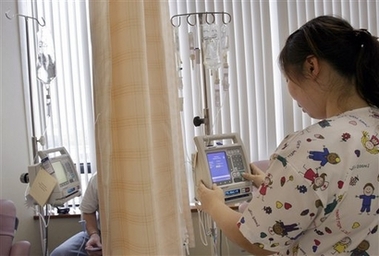Asia-Pacific
Cancer expected to skyrocket in Asia
(AP)
Updated: 2007-05-31 08:48
 |
Large Medium Small |
SINGAPORE - Asia is bracing for a dramatic surge in cancer rates over the next decade as people in the developing world live longer and adopt bad Western habits that greatly increase the risk of the disease.
 A nurse prepares a chemotherapy machine at the Cancer Institute of Singapore at the National University Hospital in Singapore, Wednesday April 18, 2007. [AP]  |
But unlike in wealthy countries where the world's top medical care is found, there will likely be no prevention or treatment for many living in poor countries.
"What happened in the Western world in the '60s or '70s will happen here in the next 10 to 20 years as life expectancy gets longer and we get better control on more common causes of deaths," said Dr. Jatin P. Shah, a professor of surgery at Memorial Sloan-Kettering Cancer Center in New York, who attended a cancer conference last month in Singapore.
"The habit of alcohol consumption, smoking and dietary changes will increase the risk of Western world cancers to the Eastern world," Shah said.
An estimated 40 percent of cancers worldwide can be prevented by exercise, eating healthy foods and not using tobacco, according to the World Health Organization.
But more people in Asia are moving into cities and becoming overweight and obese from inactivity. They are replacing fruits and vegetables with fatty meals full of meat and salt, which is leading to increases in stomach and colon cancers. Meanwhile, traditional diseases like malaria are killing fewer people - building an aging population that's a prime target for cancer.
The effect is already startling, with the Asia-Pacific making up about half of the world's cancer deaths and logging 4.9 million new cases, or 45 percent, of the global toll in 2002.
That number is projected to leap to 7.8 million by 2020 if nothing changes, according to Dr. Donald Max Parkin, a research fellow at the University of Oxford who is a leading authority on global cancer patterns and trends.
China alone, with its booming economy and 1.3 billion people, is home to about one-fifth of the world's new cases, compared to about 13 percent in the US and 26 percent in Europe, Parkin said. Heart disease remains the top killer in China, but cancer is a close second.
Cancer deaths are slowly dropping in the United States, with slight declines recorded in 2003 and 2004. A decrease in smoking, coupled with early detection and better treatment of tumors is credited with the positive results - the first US decline in cancer deaths since 1930.
Smoking is on the rise in Asia, where it's common to see people lighting up in airports, restaurants and even hospitals. Lung cancer makes up the bulk of all cases regionwide, followed by stomach and liver cancers. It also remains the biggest cancer killer worldwide.
"Lung cancer is the big one because of cigarette smoking. There are many tobacco advertisements - everywhere," said Dr. You-Lin Qiao from the Cancer Institute and Hospital in Beijing, who added that the odds are stacked against those diagnosed in China. "No matter if you're rich or poor, if you get lung cancer you die. There's no treatment at all."
| 分享按钮 |